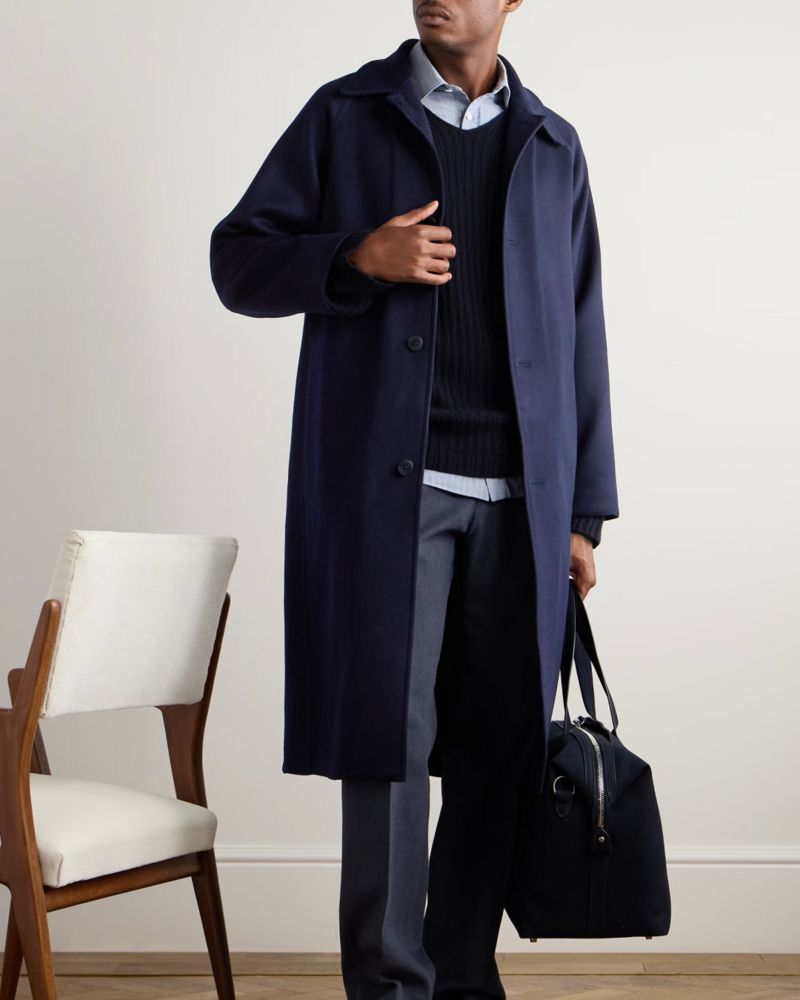THE JOURNAL

Few menswear staples have maintained their cultural and sartorial relevance as convincingly as the trench coat. Introduced in the late 19th century out of practicality, rather than style, it was first intended as a lightweight, weatherproof outer layer for army officers, complete with signature function-first details, such as epaulettes, storm flaps, D-rings and a belted waist.
Once innovated by the likes of Thomas Burberry, the garment left its military connotations behind, becoming synonymous with refined utility and classic taste – proving its everyday wearability and endless styling possibilities by way of on-screen style icons such as Robert Redford, Humphrey Bogart, Alain Delon and more.
Ever since it’s entered our sartorial lexicon, however, the trench coat has been regarded as a lightweight piece of outerwear for the in-between months, when all you need is a top layer that can withstand unpredictable showers. But it doesn’t have to be that way. As the AW25 catwalks offered up a breadth of contemporary takes on the classic, suggesting the trench can indeed be a go-to for winter, we’ve asked three experts how to pick the right one – and how to make it work for the colder months.
01. Function first

Bearing in mind its original utility features – and remembering why a trench is made the way it is – is paramount when looking for a new coat. Brands such as Burberry, TOM FORD, Polo Ralph Lauren and Brunello Cucinelli still do it the way it used to be done.
“A proper [trench coat] should fall below the knee, ideally down to the calves,” says MR PORTER’s Style Director, Benedict Browne. “Length is key. You don’t want soggy thighs. And the belt remains essential – it defines the waist and gives the coat a beautifully flattering shape.”
02. Go for heavier fabrics


If you wish to invest in something that will see you through the colder season, the key is looking for more tactile constructions, such as wool or cashmere. “Richard Gere’s cashmere camel trench in American Gigolo is a cliché menswear icon at this point, but that’s because of how amazing those images still look 45 years later,” says the fashion journalist Ashley Ogawa Clarke.
For a luxurious twist, consider leather. This material has cropped up everywhere this season. Take SAINT LAURENT’s nods to 1980s styles. AMIRI has trenches in supple leather and croc hides as well as heritage checks. Meanwhile, Brunello Cucinelli offers a suede camel style.
“A leather trench is a great way to show that you understand the classics but aren’t afraid to reinterpret them,” Browne says. “It takes an iconic silhouette and gives it a richer, more refined edge.”
03. Bet on layering

The fluid, slightly naturally billowing silhouette of the garment lends itself particularly well to layering. On cooler days, you’ll want to wear yours over a toasty knit, play with the proportions of a scarf, or wear it over a rugby shirt – with a sweater over your shoulders.
“It works well with smarter pieces, like a collared shirt with a knitted sweater, and a pair of tailored wool trousers,” Ogawa Clarke says. “The double-breasted silhouette and the belt give it more formality than most outerwear. I think it works best when you lean into it.”
04. Welcome change


“This season, it’s all about those subtle shifts – something that slightly twists the classic and moves the shape on,” says Lauren Cochrane, senior fashion writer for The Guardian and author of The Ten. “Beyond the usual khaki, for instance, or a printed style, like Dries Van Noten’s palm motif.”
Look out for different patterns – heritage checks such as houndstooth, Prince of Wales and tweed are seeing something of a revival. Also, different colours – from The Row, for example. Or even the kind of fabric contrast we can see in Drake’s new collection (in support of MR PORTER’s Health in Mind), where a utilitarian cotton-ripstop construction is complemented by a corduroy collar.